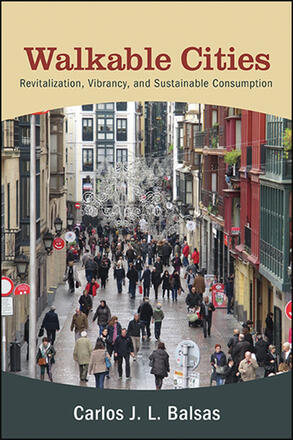
Walkable Cities
Revitalization, Vibrancy, and Sustainable Consumption
Alternative formats available from:
Examines how cities of various sizes on both sides of the Atlantic Ocean are making walkability improvements a part of their overall urban revitalization strategy.
Description
Gold Medalist, 2021 Independent Publisher Book Awards in the Transportation (Auto/Aviation/Railroad) Category
Co-Winner of the 2020 Global Division Outstanding Book Award presented by the Global Division of the Society for the Study of Social Problems
Walkable precincts have become an important component of urban revitalization on both sides of the Atlantic. In Walkable Cities, Carlos J. L. Balsas examines a range of city scales and geographic settings on three continents, focusing on the Iberian Peninsula (Spain and Portugal), Latin America (Brazil and Mexico), and the United States (Phoenix and New York City). He explains how this "pedestrianization of Main Street" approach to central locations (downtowns and midtowns) has contributed to strengthening various urban functions, such as urban vitality, pedestrian and bicyclist safety, tourism, and more. However, it has also put pressure on less affluent, peripheral, and fragile areas due to higher levels of consumption and waste generation. Balsas calls attention to the need to base urban revitalization interventions on more spatially and socially just interventions coupled with sustainable consumption practices that do not necessarily entail high growth levels, but instead aim to improve the quality of city life.
Carlos J. L. Balsas is Assistant Professor of Urban Planning at the University at Albany, State University of New York.
Reviews
"The book is well written and easy to follow. Moreover, the author also provides a useful summary and take-away key messages at the end of each chapter. Indeed, this book is suitable not just for academia, but also for all stakeholders involved with city planning and development. It is an indispensable book for people who want to create a better, livable, and sustainable city." — Regional Science Policy and Practice
"Readers interested in knowing how to enhance retailing will find this book very relevant and informative … Issues such as the regeneration of commercial and urban centers and how to bring back locals, visitors, and tourists are crucial for the economy and social lives of cities all over the world." — AAG Review of Books
"The notion of commercial urbanism is both novel and engaging, since much of the vibrancy of cities comes from commerce, consumption, and entertainment. The idea itself is a major contribution of the book." — Tridib Kumar Banerjee, University of Southern California